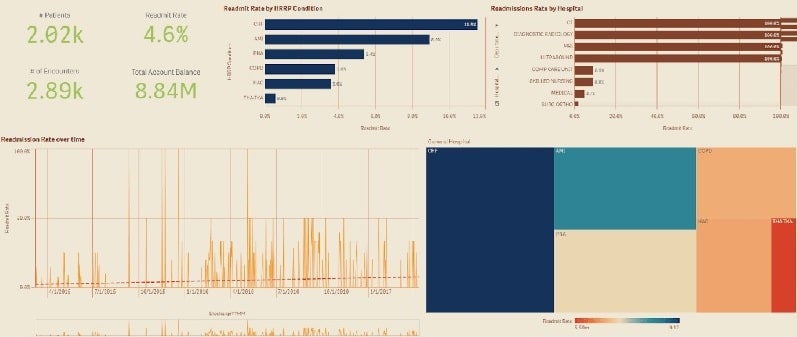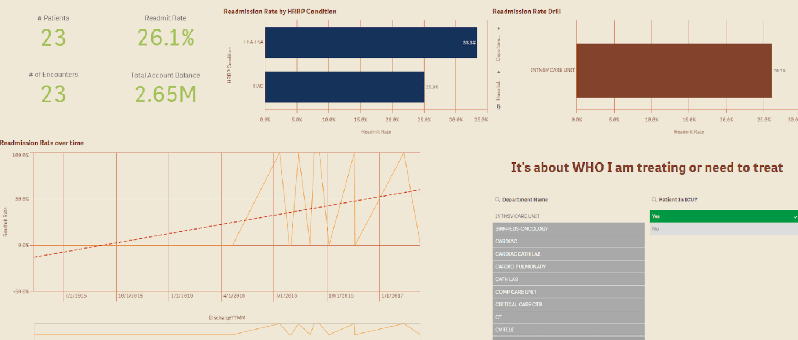
By Dalton Ruer, Data Scientist Storyteller at Qlik, a strategic DataRobot technology partner
Like many healthcare organisations around the world today, the NHS is looking to leverage predictive analytics to manage current and future capacity needs to best serve their entire patient population.
Healthcare organisations remain focused on providing the best possible care while managing resources effectively. Part of that process is limiting readmissions. During crises like COVID-19, understanding what might cause a readmission is even more crucial since the patient population is not just limited to those suffering from the virus.
Hospitals and health systems are currently under tremendous strain for resources across every aspect, be it shortages in personal protective equipment (PPE), ventilators, beds or staff hours. Being able to understand what resources are needed for non-COVID patients helps the health systems have a better view of where they might need to request additional materials and manpower support, and when.
A modern analytics platform enables the real-time analytics needed to predict patient readmittance, which, in turn, could help plan COVID-19 surge capacity.
The solution requires three key elements:
A Cloud data platform – Executing analytics against an online transactional processing system (OLTP), especially an electronic medical records system, isn’t best practice. This is especially true when considering machine learning predictive modelling. OLTP systems don’t always keep historical data, which is particularly relevant when predicting what conditions factor into readmittance. Predictive analytics that leverage machine learning need a scalable data warehouse to incorporate the historical data with the agility to keep it refreshed with real-time data.
A predictive model – There are hundreds of parameters that could factor into readmission. To understand the underlying issues, you need a predictive model. Being able to dynamically generate and test different enterprise modelling approaches to find the best model, all without code, is key. The preferred model can then be deployed and the analytics used to assess current and future needs.
Analytics that creates actionable intelligence with machine learning – Providing healthcare decision-makers with an up-to-date window into their current state of care, while also getting a data-driven sense of the strategies they need to execute to best serve their entire patient population, enables clinicians to add this data into existing workflows where they can take action.
Qlik, Snowflake and DataRobot have created such a solution which is enabling organisations like the NHS to drill down into specific modalities and departments to get a clear understanding of the where/how/why of readmittance trends. For example, providers can often recommend a wide array of options post-discharge, ranging from home healthcare services to temporary placement in a skilled nursing facility. These services may be critical to prevent readmission, but to conserve resources it’s important to target them appropriately.
The table below, for example, explores the readmittance of patients for a selected hospital within a health system followed by a view into the subset of patients who are currently in the systems’ ICU and have been readmitted in the past for two selected conditions.


The data shows that there is a very high readmittance rate for this population. By leveraging real-time data, it is possible to cross-correlate to both understand and predict much more clearly how to plan around current care needs, capacity and resource planning.
This visibility not only gives front line caregivers both the targeted population they need to focus on for potential readmittance issues, but also the underlying reasons related to each patient to even further focus the care plan. It’s worth noting that healthcare payers are keenly interested in preventing readmissions to improve patient experience and reduce costs so they can also use these targeted predictions and visualisations to provide more targeted follow-up care and care management.
“There are so many areas where data science can help enable more effective care, from live and capacity demand management, to predicting length of stay, to alignment on discharge and lower care demands for patients exiting acute care. For example, being able to understand our current patient population’s risk for readmittance is crucial to effectively executing unscheduled demand forecasting to manage an influx of crisis related patients,” said Rob O’Neill, Head of Information for University Hospitals of Morecambe Bay NHS. “Combining data science and analytics through an integrated platform will help us more confidently understand our current needs and predict what resources we will need to deliver complete care to our entire patient population.”
The COVID-19 pandemic and its hourly changing conditions have put a premium on healthcare systems being able to make decisions in real-time while also predicting as much as possible what resources they will need for likely surges. Bringing together a real-time data warehouse, machine learning predictive modelling and modern business intelligence, it is hoped that readmittance data will become part of the solution for COVID-19 related care.








